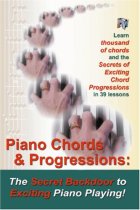Major 6th Chords: Root, 3rd, 5th & 6th
Major 6th Chords Add a Bit of Color To Triads
| Good morning, this is Duane and we’ve covered the triads. The 48 basic triads, major triads, minor triads, diminished triads, and augmented triads. Now, we’re going to move to 4 note chords. 4 note chords add a great deal of dimension to any kind of piano playing at all or to any kind of music for that matter. We’re going to take up major 6th chords today. A major 6 chord is simply where you add the 6 note of the scale to the basic chord. For example, that’s C major and if I add the 6th note of the scale 1, 2, 3, 4, 5, 6. There it is, I add the 6th to the C major chord and that C major 6. Or just known as C6.
|
| Now, I can turn that upside down can’t I? Could be in first inversion. It’s the same 4 notes it’s just upside down. I can turn it upside down again, same 4 notes just upside down. Now, I can turn it upside down again and it’s the same chord, it’s C6, but A’s on the bottom so it has a little different feeling, right? Sound like an A minor 7th chord. In fact, it is an A minor 7th chord, but if you put the C on the bottom here of the chord then you’ve got a C6 for sure. What I’m saying is there’s a relationship between a C6 and an A minor 7th chord because they have the very same notes. That’s true of all 6 chords and minor 7 chords, they have a kissing cousin, a related minor chord, minor 7th chord, and that changes the flavor of the piece. That gives you a great advantage if you’re an arranger, okay?
|
| For example, if I’m playing Silent Night. Well I could play C6 there couldn’t I? That sounds fine, but what if I put A on the bottom? It changes the feeling, doesn’t it? It gives you another tool in your tool box of arranging. Lets go through all the major chords and add a 6. Notice that a 6 is one whole step above the 5th. Whatever the top note of the chord is or the 5th of the chord is, you go up a whole step. Not a half step, whole step. Okay, so that’s C6. Here’s the F major chord, that would be F6. Here’s the G chord, that would be G6. Here’s the D major chord, that would be D6. Here’s the E major chord, where is E6? Right, it wouldn’t be here would it because that’s only half step so you got to go up. That’s the 6th note of the E scale. If you play the E scale, you will see that’s the 6th note, okay?
|
| On A, that’s the A major chord and that’s A6. Again, a whole step above the 5th. D flat major, D flat major 6. E flat major, E flat major 6. A flat major, A flat major 6. G flat major, G flat major 6. B major, B major 6. B flat major, B flat major 6. Okay. Now, we won’t talk about what we can do with these chords, but there’s so many things we can do with 6 chords. For example, we could use 2:1 breakups. We could play 2 notes and then 1. 2, 1, 2, 1. Or 2, 2. Or we could straddle it, we could take up. So there’s the 4 notes of the chord, we could do this. You’ve heard that kind of thing and that’s where that comes from. Okay, we’ll talk about that in the days to come. That’s it for today. If you enjoy these little tips come on over to playpiano.com and sign up for our series of tips on video and instructional stuff. Hope to see you there. Bye, bye for now.
Click on this link to watch this video on YouTube: https://www.youtube.com/watch?v=LiCncHzGYz0 ***For lots more good stuff on piano playing come on over to my website at https://www.playpiano.com and sign up for our free piano tips – “Exciting Piano Chords & Sizzling Chord Progressions!” Here’s a great little book on chords and chord progressions on Amazon: http://www.amazon.com/Piano-Chords-Chord-Progressions-Exciting-ebook/dp/B0076OUGDE/ref=sr_1_1?s=books&ie=UTF8&qid=1404158669&sr=1-1&keywords=piano+chords+duane+shinn |




